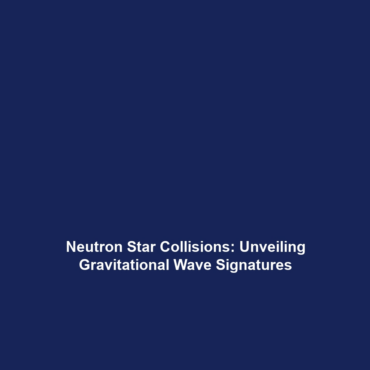Neutron Star Collisions: Mergers of Neutron Stars and the Unique Gravitational Wave Signatures They Produce
Introduction
Neutron star collisions represent one of the universe’s most dramatic cosmic events, offering a glimpse into the workings of general relativity and the fabric of spacetime. These mergers not only result in the formation of new astronomical bodies but also emit unique gravitational wave signatures detectable from Earth. Understanding these phenomena is crucial for astrophysics, as it sheds light on the mechanisms behind gravitational waves and the extreme conditions present in the universe. This article delves into the significance of neutron star collisions within the broader context of gravitational waves.
Key Concepts
Understanding Neutron Stars
Neutron stars are incredibly dense remnants of massive stars that have undergone supernova explosions. Characterized by their mass, which can exceed that of the Sun but compressed into a sphere about 20 kilometers in diameter, these stellar objects exhibit astonishing properties, including:
- Extreme Density: A sugar-cube-sized amount of neutron-star material weighs about 1 billion tons.
- Rapid Rotation: Many neutron stars, known as pulsars, rotate at astonishing speeds, up to several hundred times per second.
The Process of Merging
When two neutron stars approach each other under the influence of their gravitational pull, they eventually merge, producing a colossal release of energy in the form of gravitational waves. The unique signatures of these waves are vital for astrophysics:
- Gravitational Wave Signatures: The frequencies and amplitudes of the emitted gravitational waves provide insight into the masses and spins of the neutron stars involved.
- Multi-Messenger Astronomy: Accompanying electromagnetic signals can lead to a comprehensive understanding of the merger’s aftermath, including kilonova explosions.
Applications and Real-World Uses
The study of neutron star collisions has significant implications within the field of gravitational waves. Key applications include:
- Astronomical Measurements: Gravitational wave signals from neutron star mergers help refine models of cosmic distance and the expansion of the universe.
- Nuclear Physics: Insights gained from these collisions can enhance our understanding of the properties of nuclear matter under extreme conditions.
- Education and Outreach: These events serve as case studies in explaining complex astrophysical themes to the public and students alike.
Current Challenges
Despite advancements, several challenges remain in studying neutron star collisions and their gravitational wave signatures:
- Detection Limitations: Current technology may miss weaker signals from distant collisions.
- Data Overload: The large volume of data generated complicates the analysis process.
- Theoretical Models: Developing accurate theoretical models to predict merger outcomes requires continual refinement.
Future Research and Innovations
The future of research surrounding neutron star collisions looks promising, with innovations on the horizon. Key areas of research include:
- Next-Generation Observatories: Upcoming facilities like the Einstein Telescope aim to enhance detection capabilities of gravitational waves.
- Advanced Simulation Techniques: Utilizing supercomputers to simulate neutron star mergers may lead to better predictions of gravitational wave signatures.
- Interdisciplinary Approaches: Combining insights from physics, astrophysics, and computer science to develop new methodologies for understanding these cosmic events.
Conclusion
Neutron star collisions are not only a spectacle of the cosmos but also pivotal in our understanding of gravitational waves. The unique signatures produced during these mergers provide invaluable data that enriches both the fields of astronomy and physics. As research and technology advance, the horizon for discoveries concerning gravitational waves will broaden. To stay informed about related topics, explore our other articles on gravitational waves and astrophysics.


